A longboard tailored for beginners is the ideal starting point for new skaters looking to enjoy the sport of longboarding. It should come equipped with soft wheels (78a-85a) for superior grip and shock absorption, flexible bushings to aid in smooth turns, high-quality ABEC-7 or ABEC-9 bearings for optimal performance and durability, and safety features like non-slip grip tape and reflective materials. Beginners should invest in protective gear such as a helmet, knee pads, and elbow pads for added security. Regular maintenance is essential to keep the board in top condition, including cleaning after each ride, inspecting and tightening hardware, servicing bearings, and checking wheels and bushings for wear. As skills progress, advanced features like harder wheels or precision bearings can be considered for a more responsive and faster experience, always prioritizing safety and comfort throughout the learning process. Consistent practice and a patient approach will help beginners develop their techniques and eventually master more complex aspects of longboarding.
Embark on a seamless journey with a longboard tailored for beginners, where each wheel roll promises an adventure. This comprehensive guide will navigate you through the essentials of longboarding, from deciphering the deck’s design to selecting the perfect wheels for your skating style. Understand the stability offered by trucks and bushings, the role of bearings in a smooth ride, and the necessity of safety gear for every excursion. With insights into mastering basic techniques and maintaining your longboard, you’ll glide with confidence and longevity.
Discovering the Best Longboard for Beginners: A Comprehensive Guide
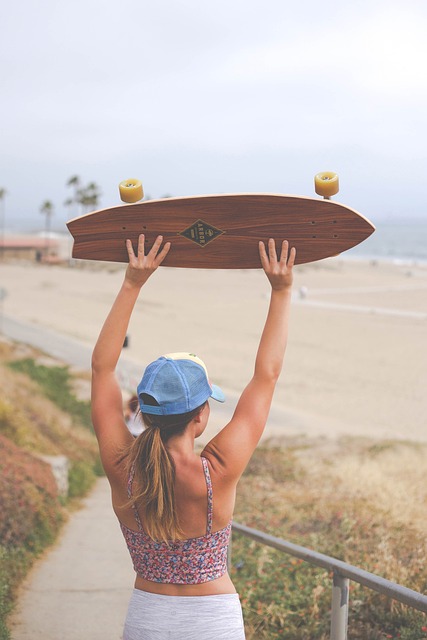
Embarking on the journey of longboarding can be an exhilarating experience, and selecting the right longboard is paramount for a smooth cruising experience, especially for beginners. The best longboard for novices should offer stability, ease of use, and a balance between speed and maneuverability. When choosing a longboard, consider factors such as deck size, wheel type, truck responsiveness, and overall design that cater to the learning curve of a beginner. A longer deck with a slightly concave shape is often more stable for those just starting out, providing a broader platform for foot placement. Wheels ranging from 65mm to 70mm offer a good compromise between speed and grip, while softer durometers can handle rough terrain and provide better shock absorption. Trucks with a higher degree of responsiveness allow for easier turning, which is crucial for developing confidence and skills. Additionally, bearings that are ABEC-rated can significantly impact the smoothness of your ride. It’s advisable to read reviews, watch tutorials, and even seek advice from experienced longboarders or shop employees to find the model that best suits your needs as a beginner. By investing in a well-rounded longboard tailored for beginners, you set the stage for a rewarding longboarding adventure.
Understanding the Anatomy of a Longboard: Key Features to Look For
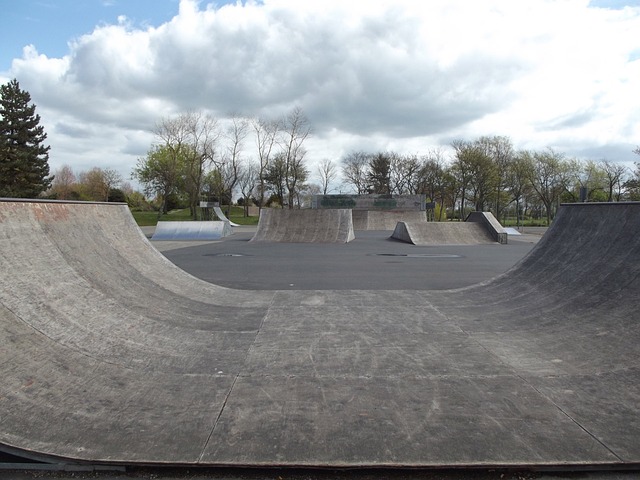
Embarking on a journey with a longboard designed for beginners requires an understanding of its key features that contribute to a smooth cruising experience. The deck, or platform, is the foundation of the longboard and should offer a generous width and concave profile for stability and foot control. A longer wheelbase enhances the board’s stability, making it easier for novices to maintain balance and navigate smoothly. The trucks, which connect the deck to the wheels, are pivotal in steering; they should have a responsive and stable geometry that can handle the learning curve of a beginner.
When selecting a longboard for beginners, consider the wheel durometer, which measures hardness. Softer wheels (typically 70-80a durometer) offer better grip and are more forgiving on rough surfaces, making them ideal for newcomers who are still honing their skills. The wheel size also plays a role; larger wheels (usually around 60-75mm) roll over pebbles and cracks with ease, providing a smoother ride without the constant need to dodge obstacles. Additionally, bearings can significantly affect the longboard’s performance. High-quality bearings ensure a seamless glide, minimizing friction and effortlessly carrying you through your cruising adventures. Understanding these components will help beginners choose a longboard that not only fits their skill level but also enhances their enjoyment of the sport.
Deck Size and Shape: Finding Your Ideal Ride

For those embarking on their journey with a longboard, the deck size and shape play pivotal roles in crafting an optimal cruising experience. A beginner’s longboard deck should strike a balance between stability for new riders and the versatility to handle various terrains. Deck length can significantly influence the board’s maneuverability; longer decks offer greater stability, making them ideal for covering distance and maintaining speed. Conversely, shorter decks are more responsive and agile, suited for navigating through crowded streets or tight turns. The shape of the deck also contributes to the ride’s comfort and performance. A slightly concave design helps in foot positioning, providing a secure foothold while allowing for fluid movements. Choosing between a symmetrical or directional deck depends on the rider’s intended use; symmetrical decks enable a goofy stance—riding with one foot forward in whichever direction—ideal for freeriding and cruising, while directional decks are designed for downhill racing or carving, where a specific stance and direction offer better control. Selecting the right longboard deck size and shape is a key step for beginners to ensure their ride aligns with their skill level and intended use, leading to an enjoyable and safe cruising experience. Whether you’re looking to glide through campus or explore urban landscapes, the ideal longboard deck will help you find your rhythm and embrace the smooth cruising that longboarding offers.
Wheel Types and Durometers: Choosing the Right Roll for Your Skating Style

When embarking on a journey with a longboard, selecting the appropriate wheel type and durometer is pivotal to achieving a smooth cruising experience. Longboards are versatile platforms that cater to various skating styles, and understanding the relationship between wheels and your chosen style can significantly enhance your ride. For beginners, softer wheels typically range from 78a to 85a on the durometer scale and offer better grip and shock absorption, which is ideal for navigating urban environments or making your first carves along a scenic route. These soft wheels are more forgiving over cracks and imperfections in the pavement, allowing you to maintain balance and control as you acclimate to the longboard’s larger deck.
As you progress and explore different terrains, you may find yourself drawn to harder wheels for their increased speed and roll efficiency. Wheels within the 86a to 95a range are often preferred for downhill racing or technical freeriding, as they provide less rolling resistance and can handle higher speeds. However, it’s important to balance performance with safety; harder wheels, while faster, offer less traction, so beginners should proceed with caution. The choice of wheel also depends on the type of longboard—cruisers typically use larger, softer wheels for a smooth ride, whereas downhill boards might employ smaller, harder wheels for speed and efficiency. Always consider your skating style and environment when selecting your longboard’s wheels, as this will directly influence your overall experience and performance on the board.
Trucks and Bushings: The Backbone of Stability in Longboarding
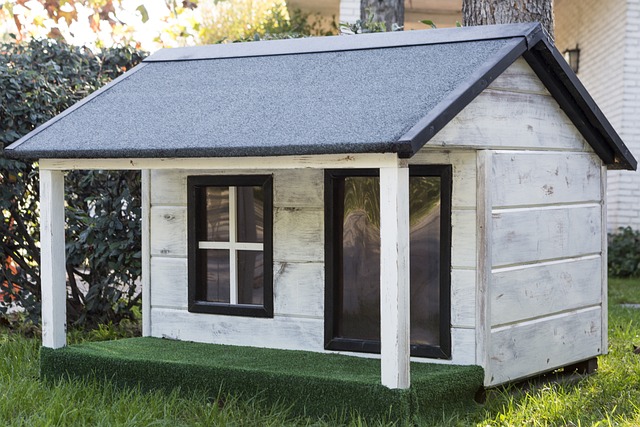
When it comes to the world of longboarding, stability is paramount for a smooth cruising experience. Trucks and bushings are the unsung heroes that form the backbone of this stability, particularly important for beginners who prioritize balance and control as they navigate their longboard journey. The trucks, which are the metal hinges attached to the deck of the board, allow for the turning motion essential for maneuvering through diverse terrains. They work in tandem with bushings, soft rubber pieces that fit inside the trucks, to provide a responsive and adaptable ride. These bushings act as shock absorbers, dampening vibrations from imperfect roads or rough terrain, thus enhancing the rider’s comfort and control. For beginners, selecting the right combination of truck size and bushing durometer is crucial for an optimal experience. Softer bushings offer more flex, which can be beneficial for those just starting out, as they tend to provide a smoother ride and easier turns. As one progresses from novice to seasoned rider, the setup might evolve, but the role of trucks and bushings in maintaining stability and comfort remains key in longboarding. Opting for a longboard designed with beginners in mind, complete with appropriately chosen trucks and bushings, can significantly ease the learning curve and contribute to a more enjoyable and safe longboarding adventure.
Bearings and Their Impact on a Smooth Ride

When embarking on a journey, whether it’s a casual ride to the local park or an extended skate across town, beginners on a longboard will find that having the correct bearings is paramount for a smooth cruising experience. Longboard bearings, specifically those with high precision and durability like ABEC-7 or ABEC-9 ratings, are designed to minimize friction and maximize roll efficiency, which in turn allows for a fluid and responsive ride. These bearings are engineered with tight tolerances, ensuring that they rotate smoothly under varying loads and terrains. For those just starting out on their longboarding journey, it’s crucial to invest in high-quality bearings as they directly impact the ease of gliding and the longevity of your ride. Properly maintaining and replacing bearings regularly can prevent wear and tear, keeping your longboard for beginners running smoothly and safely, even as you progress from novice to more experienced rider. Additionally, the bearing setup, including the spacers and washers that accompany them, should be configured correctly to optimize performance and stability on your longboard, contributing significantly to a seamless and enjoyable riding experience.
Safety Gear: Protecting Yourself on Every Longboard Journey
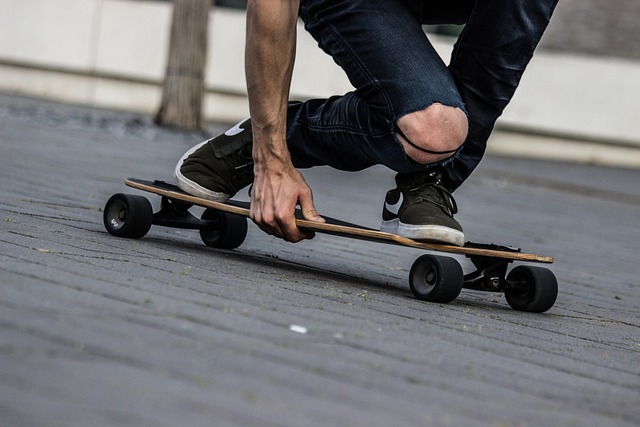
Embarking on a longboard journey, whether it’s for leisure or commuting, requires a commitment to safety. For beginners especially, the right protective gear is paramount to ensure a smooth cruising experience and prevent potential injuries. A sturdy helmet is an essential piece of equipment, designed to safeguard your head in case of falls or collisions. Additionally, knee and elbow pads provide critical support, allowing novice longboarders to learn and maneuver with confidence. The choice of longboard for beginners should also consider built-in safety features such as grip tape that prevents feet from slipping off the board and reflective materials enhancing visibility during low-light conditions. Protective gear like wrist guards can further mitigate the risk of injury by supporting your arms and hands, which are often used to balance and steer. Investing in quality safety gear not only contributes to a safer experience but also fosters a longer-lasting enjoyment of longboarding as a hobby or mode of transportation. Ensuring that all protective equipment is properly fitted and worn consistently will help you navigate the urban landscape or scenic trails with peace of mind, knowing that you are well-prepared for a safe and exhilarating ride.
Mastering Basic Techniques: Cruising Confidence for New Longboarders

Embarking on the exhilarating journey of longboarding can be a transformative experience for new enthusiasts. To ensure a smooth cruising experience, mastering basic techniques is paramount. A longboard designed for beginners will offer a stable platform to learn and grow in confidence. Initially, focusing on fundamental skills such as pushing, turning, and balancing is crucial. Proper foot placement and weight distribution are key elements that will enhance stability and control, allowing riders to navigate with ease. As newcomers become familiar with these techniques, their proficiency on the longboard will evolve, leading to a more enjoyable and confident ride. Practicing in an open, safe environment is recommended to refine these skills without the pressure of traffic or complex terrains. By gradually introducing new maneuvers and gradually increasing speed, beginners can build a solid foundation that will serve them well as they progress to more advanced techniques. Regular practice and patience are essential components for any beginner looking to transition from tentative rider to confident longboarder.
Maintenance Tips: Keeping Your Longboard in Optimal Condition for Years of Enjoyment
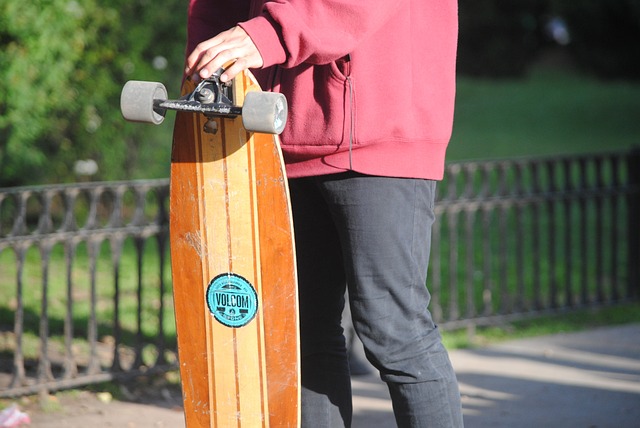
Regular upkeep is pivotal in maintaining a longboard’s performance and longevity, especially when it comes to a longboard for beginners that will likely see a lot of use. To ensure your board glides smoothly for years to come, start by giving it a thorough cleaning after each ride. Remove dirt, debris, and any moisture that can compromise wheel grip and bearing performance. Use a soft brush or cloth to clean the deck, trucks, and wheels properly. After cleaning, inspect the hardware for signs of wear or looseness. Tighten any nuts and bolts as needed, and consider using anti-seize compound on threads to prevent corrosion and ease future maintenance.
Next, examine the bearings, which are critical for a seamless ride. Spin each bearing by hand to check for smooth rotation; if they feel gritty or seize up, disassemble and clean them with mild soap and water, then lubricate with high-quality skate bearing oil. Pay attention to the bushings, which absorb shock and keep your truck aligned. Over time, these can compress and lose resilience, affecting your board’s responsiveness. Replace them as they lose their original firmness. The wheels also need attention; check the urethane for cracks or gouges and replace them if compromised. A well-maintained longboard for beginners will provide a more enjoyable and safer experience, making the most of your investment in this fun and exhilarating sport. Remember to store your board in a cool, dry place away from direct sunlight to prevent material degradation. With these maintenance tips, you can keep your longboard in optimal condition, ready for countless adventures on the pavement.
